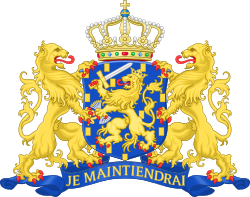Second Colijn cabinet | |
|---|---|
| Cabinet of the Netherlands | |
 The first meeting of the Second Colijn cabinet on 26 May 1933 | |
| Date formed | 26 May 1933 |
| Date dissolved | 31 July 1935 (Demissionary from 23 July 1935) |
| People and organisations | |
| Head of state | Queen Wilhelmina |
| Head of government | Hendrikus Colijn |
| No. of ministers | 11 |
| Ministers removed | 4 |
| Total no. of members | 13 |
| Member party | Roman Catholic State Party Anti-Revolutionary Party Christian Historical Union Liberal State Party Free-thinking Democratic League |
| Status in legislature | Centre-right majority government |
| History | |
| Election | 1933 general election |
| Legislature terms | 1933–1937 |
| Predecessor | Third Ruijs de Beerenbrouck cabinet |
| Successor | Third Colijn cabinet |
| This article is part of a series on |
| Politics of the Netherlands |
|---|
 |
The Second Colijn cabinet was the cabinet of the Netherlands from 26 May 1933 until 31 July 1935. The cabinet was formed by the Roman Catholic State Party (RKSP), the Anti-Revolutionary Party (ARP), the Christian Historical Union (CHU), the Liberal State Party (LSP) and the Free-thinking Democratic League (VDB) after the 1933 general election. The centre-right cabinet was a majority government in the House of Representatives. It was the second of five cabinets of Hendrikus Colijn, the Leader of the Anti-Revolutionary Party as Chairman of the Council of Ministers. [1] [2] [3] [4] [5]












